IP Office 500 Base Cards
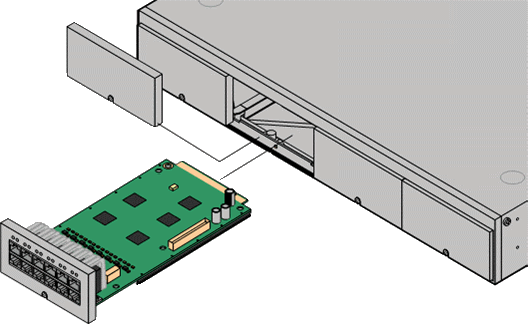
The IP500 control unit has 4 slots for the insertion of cards. These cards can be divided into two types; base cards and daughter cards. Base cards include a front panel and ports for cable connections. Daughter cards can be added to a base card in order to provide additional facilities (typically trunk connections).
The following base cards are available:
- Digital Station 8 Card (Max. 3)
- Analog Phone 2 Card and Phone 8 Card (Max. 4)
- VCM Card (Max. 2)
- 4-Port Expansion Card (Max. 1)
- Legacy Card Carrier (Max. 2)
- Combination Card with 4 Analog Trunks (Max. 2, no daughter card, IP500 V2 only).
- Combination Card with 2 BRI Trunks (Max. 2, no daughter card, IP500 V2 only).
Digital Station 8 Card
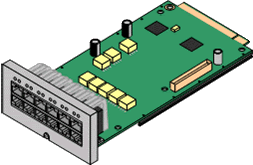
This card provides 12 RJ45 ports. The first 8 ports are DS ports for the connection of AVAYA digital phones other than IP phones. The card can be fitted with an IP Office 500 daughter trunk card, which then uses the additional 4 RJ45 ports for trunk connections.
This card accepts one IP 500 trunk daughter card of any type.
4400 Series phones (4406D, 4412D and 4424D) are not supported on this card, only on Digital Station expansion modules. Therefore a maximum of 240 4400 Series phones are supported in the system.
Analog Phone 2 Card
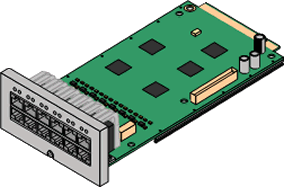
This card provides 2 analog extension ports (1-2) for the connection of analog phones. The card can be fitted with an IP Office 500 daughter trunk card, which then uses the last 4 RJ45 ports (9-12) for trunk connections.
This card accepts one IP 500 trunk daughter card of any type.
Analog Phone 8 Card

This card provides 8 analog extension ports for the connection of analog phones. The card can be fitted with an IP Office 500 daughter trunk card, which then uses the additional 4 RJ45 ports for trunk connections.
This card accepts one IP 500 trunk daughter card of any type.
Combination Card with 4 Analog Trunks
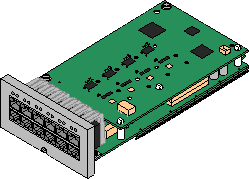
This card works in the IP500 V2 only and provides:
- 4 Analog trunk ports
- 2 Analog extension ports, for analog phones
- 6 Digital Station (DS) ports, for Avaya digital phones
- 10 VCM channels to support IP telephones or voice networking
This card already includes an IP500 trunk card, therefore no additional trunk card is possible. It provides a single power-fail port: during power failure phone port 8 is connected to analog trunk port 12. A maximum of two of these cards is allowed in the control unit.
Combination Card with 2 BRI Trunks
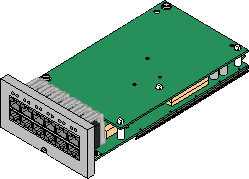
This card works in the IP500 V2 only and provides:
- 2 BRI trunk ports (4 Channels)
- 2 Analog extension ports, for analog phones
- 6 Digital Station (DS) ports, for Avaya digital phones
- 10 VCM channels to support IP telephones or voice networking
This card already includes a IP500 trunk daughter card, therefore no additional daughter card is possible. A maximum of two of these cards is allowed in the chassis.
VCM Card
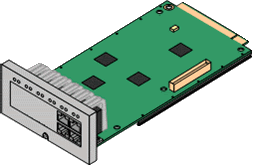
This card provides voice compression channels for use with VoIP calls, SIP trunks and IP-based voice networking. The module is available in variants supporting up to 32 or 64 channels.
The maximum number of voice compression channels supported, using IP500 VCM base cards, Combination Cards and / or IP400 VCM cards on IP500 Legacy Card Carriers, is 148.
Note, the maximum number of channels which may be used on each IP500 VCM card varies according to the codec used, as shown in the following table.
| VCM 32 | VCM 64 | Combi. | |
|---|---|---|---|
| G.711 | 32 | 64 | 10 |
| G.729 | 30 | 60 | 10 |
| G.723 | 22 | 44 | 10 |
| G.722 | 30 | 60 | 10 |
This card accepts one IP500 trunk card of any type.
Unified Communications Module
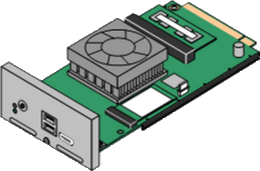
This card acts as an embedded Linux server for the one-X Portal for IP Office and/or Voicemail Pro applications.
4-Port Expansion Card
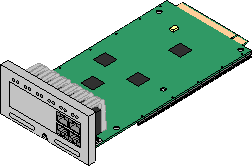
- This card provides connectors for 4 additional expansion modules.
- The 4-port expansion card must be inserted in slot 4 of the control unit.
- It is not possible to connect a daughter card to the 4-port expansion card.
Legacy Card Carrier
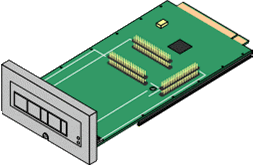
This card allows a variety of IP400 trunk and VCM cards to be used with the IP Office 500 control unit. The front of the card includes a number of panels that can be snapped off to match the ports available when an IP400 trunk card is fitted.
- This card does not accept any IP 500 daughter trunk cards.
- The IP Office 500 control unit can accept up to 2 IP400 trunk or VCM cards by mounting each card on an IP Office 500 Legacy Card Carrier
This card supports the following IP400 cards:
- PRI T1
- Dual PRI T1
- PRI 30 E1 (1.4)
- Dual PRI E1
- PRI 30 E1R2 RJ45
- Dual PRI E1R2 RJ45
- ANLG 4 Uni
- BRI-8 (UNI)
- VCM 4
- VCM 8
- VCM 16
- VCM 24
- VCM 30
Trunk Cards
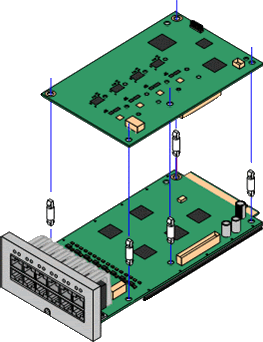
IP Office 500 daughter trunk cards can be fitted to existing IP Office 500 base cards to provide support for trunk ports. The daughter card uses the ports provided on the base card for cable connection. The addition of a daughter trunk card is supported on IP Office 500 Digital Station, Analog Phone and VCM base cards. They are not supported on the Avaya Legacy Card Carrier base card.
For those base cards that support daughter cards, there are no restrictions on the combination of card types. However in systems with both analog phone 8 base cards and analog trunk daughter cards, combining the two types are recommended as it then provides analog power failure support for two trunks/extensions. (Not applicable to the Analog Phone 2 base card.) Each daughter card is supplied with the spacer pegs required for installation and a label to identify the cards presence on the physical unit once installed.
- Analog Trunk Card (Max. 4)
- BRI Trunk Card (Max. 4)
- PRI Trunk Card (Max. 4)
Analog Trunk Card
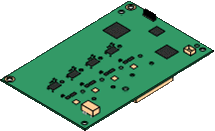
This card can be added to an IP Office 500 Digital Station card, Analog Phone base card or VCM card. It allows that card to then also support 4 analog loop-start trunks. It also provides one analog V.32 modem.
When fitted to an IP 500 Analog Phone 8 base card, the combination supports 1 power failure extension to trunk connection.
BRI Trunk Card (Euro ISDN)
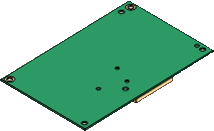
This type of card can be added to an IP Office 500 Digital Station card, Analog Phone card or VCM card. It allows that card to then also support up 4 BRI trunk connections, each trunk providing 2B+D digital channels. The card is available in 2 port (4 channels) and 4 port (8 channels) variants.
From IP Office release 4.2 onwards, the ports on IP500 BRI cards can be individually configured to operate as an S-interface (S0 mode). When set as an S interface the settings for the Line will be exactly the same as for a circuit on an So8 Expansion Module.
These trunks support the mobility features of Mobile Call Control and one-X Mobile client support introduced in Release 4.2.
PRI Trunk Card

This type of card can be added to an IP500 Digital Station card, Analog Phone card or VCM card. It allows that card to then also support primary rate digital trunk connections. Available in single and dual versions the IP500 PRI card provides single and dual primary rate trunk interfaces respectively. The PRI is configurable for T1, E1 or E1R2 MFC use depending on the territory.
Details of the supported ISDN supplementary services and protocols for each PRI are given in the 'Public and Private Voice Networks' section.
The IP500 Universal PRI trunk cards incorporate an integrated CSU/DSU. The CSU function allows the trunk to be put in loop-back mode for testing purposes. This can be set manually, using the monitor application, or automatically from a Central Office sending a Line Loop Back (LLB) pattern. The DSU function allows the T1 trunk to be shared between data and voice services.
Summary of the cards capabilities:
- Each card is configurable to connect to T1, E1 or E1R2 lines.
- Available in either single or dual PRI variants. The single variant can support up to 24 T1 channels or up to 30 E1 channels. The dual variant can support up to 48 T1 channels or 60 E1 channels.
- On each card, 8 channels are enabled by default. Further channels may be enabled by purchasing additional licenses in 2 or 8 channel increments.
- The IP500 PRI daughter card works on any IP500 VCM or extension base card (not the Legacy Card Carrier).
- Up to four Universal PRI cards can be installed in any combination in the IP500 or IP500 V2 chassis.
- Supports mobility features of Mobile Call Control and one-X Mobile client introduced in Release 4.2.
- Visual indicators to show service state, and Physical test points to monitor traffic.